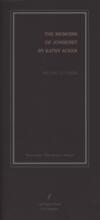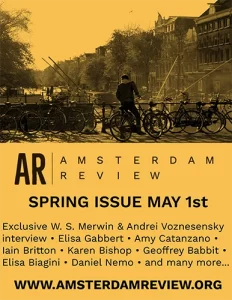The Memoirs of JonBenet by Kathy Acker
This book of thirteen short essay-stories, The Memoirs of JonBenet by Kathy Acker by Michael du Plessis, is dense with conflated cultural images that construct an alternate unreal-real reality of consumer America. The story’s location is Boulder, Colorado, in a a snowglobe, the kind bought at a “cheap airport gift store and stuck at the foot of the Rocky Mountains.” Boulder is also the place where JonBenet, a six-year-old beauty pageant queen and possibly one of the narrators, was murdered on Christmas Eve in 1996. The other possible narrator of this “fiction inside a fiction” is the dead writer Kathy Acker. Then, there is another narrator, as JonBenet and Kathy Acker discuss: “Somewhere a narrator still worries, almost like a grown-up.” These narrators “out” each other and often call attention to the narrative as a narrative.
This book of thirteen short essay-stories, The Memoirs of JonBenet by Kathy Acker by Michael du Plessis, is dense with conflated cultural images that construct an alternate unreal-real reality of consumer America. The story’s location is Boulder, Colorado, in a a snowglobe, the kind bought at a “cheap airport gift store and stuck at the foot of the Rocky Mountains.” Boulder is also the place where JonBenet, a six-year-old beauty pageant queen and possibly one of the narrators, was murdered on Christmas Eve in 1996. The other possible narrator of this “fiction inside a fiction” is the dead writer Kathy Acker. Then, there is another narrator, as JonBenet and Kathy Acker discuss: “Somewhere a narrator still worries, almost like a grown-up.” These narrators “out” each other and often call attention to the narrative as a narrative.
In the first chapter, Kathy Acker says she has “turned into JonBenet, a grown-up doll who looks in the mirror, sees nothing there, and likes it like that.” This, of course, happened, perhaps due to the invisible, hidden, amorphous realm of a toxic culture: “An accident of radioactive waste, a side effect of tampering with gene codes? A mistake of military technology, wafted on the wind from Colorado Springs?”
Kathy Acker, as JonBenet, tells us she is not really JonBenet, and then she tells us she is not really a JonBenet™ doll—“but anything can happen in Boulder”:
I’m a dead writer trapped in the body of a plastic doll.
I’m a plastic doll in the body of a dead writer.
Both of us are trapped in a snowglobe.
I don’t know who is writing this, Kathy or JonBenet.
The dolls, JonBenet™ and Kathy Acker™, images based on the dead, are replicas, copies; they are plastic, twelve inches tall, with a string in their necks that when pulled makes them talk . . . they have an interior life, they date, fall in love, have infidelities, look for true love, go to doll school, have doll friends, take doll Valium, have dollgasms. We see ourselves with their eyes, and our created products, in ventriloquism, say no to the lifeless life of “totalitarian capitalism” the “real” represents. Kathy warns JonBenet about the Blue Fairy who wants to make them real, but they are not like Pinocchio or the Velveteen Rabbit, they don’t want to be real: “for only what can die is real.” They’ve already done that and are now on the other side, free to make something new. With the transforming spontaneity of a dream, of a fairy tale, we are immersed in Boulder as a replica of all America and its production of mind-numbing territories of replication—“the creeping, omnipresent, utterly inescapable fungus of the beige wall-to-wall carpet” everywhere and:
Structures of the 1970s, they promised the good life of the American Bicentennial in the raw materials—particle board, polyresin, reinforced Tupperware, drywall, polyester, pressed wood shingle, polyurethane—the flammable and cheap fabric from which the American Dream is spun.
Literature, as we have known it, is denuded; Steinbeck, Roth, Updike, Hemingway, et al. are “transparent pseudonyms of Stephen King!” The Great American Novel is nothing more than “a conspiracy that permits the conspiracy, the belief in the great American Empire.” The images and products we have made have taken on voice and look at us, and, of course, “they” are looking at us, projected ghosts and golems we have created, engage us back from their location outside us . . . “we” are their referents. Thankfully, they are not real from “their point of view.” JonBenet and Kathy in a wide-angled eye look at us, indicting the culture. They say they don’t want to be real, that what we, on the real side, have is death. The doll Kathy Acker™, replica, copy, simulation, product, says of us: “ . . . the Unreal that maintains steadfastly, arrogantly, unstoppedly, that it is Real.” These dolls, these replicas, these products, these concepts as 3-D images, don’t find enough life here. They experience a waffling center with no one at home, and they decide to leave and not carry on the legacy of “this” culture, as there is no life left to live for. Our thoughts in the shape of plastic dolls don’t want to stick around; they don’t want to be there to turn off the light at the whimpering end. Then, of course, this is the heart of a fairy tale, a Stephen King ending . . . JonBenet-Carrie, the doll that the Blue Fairy made real and died, is on her way, resurrected in a dream, to take her revenge: “You can’t keep a good doll down.”
The Memoirs of JonBenet by Kathy Acker is composed by way of many postmodern writing techniques: metafiction, writing calling attention to itself undermining the author’s authority; synecdoche, Boulder representing all of America; metonym, Stephen King representing traditional literature of the modern era and its demise with the best-seller industry; questionable narrator, multiple points of view with JonBenet, Kathy Acker (we are inside their wants and desires) and the author (feeling caught by surprise of how the narrative moves, and, yet, concerned for them); irony, the dolls created by a world they reject; genres and subjects combined, outside the bounds of legitimate subjects for literature with social critique inside hyperreality (life lived as information, not distinguishing reality from a simulation of reality) inside a fairy tale, that permits believable, spontaneous conceptual turns; and the serious subject of JonBenet used in a Mad Magazine way showing consumer culture’s debasement of childhood and Kathy Acker, as a doll, doing what she did when alive, undermining consumerism’s (snowglobe) anesthesia. Du Plessis, in clear and sparkling prose, has left us in a queasy space of our products and processes looking back at us as referents for them. Experientially dizzying to be shown this with animatronic-flavored images. The “self,” created by consumer-oriented capitalism, now a referent for products and processes. After all, they now come with names like, “iPod.”





